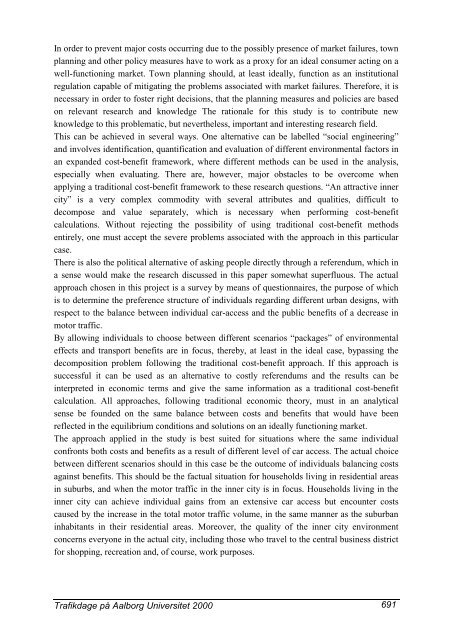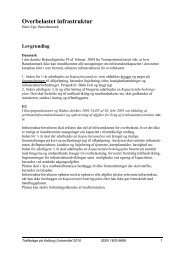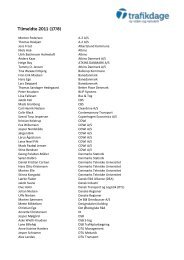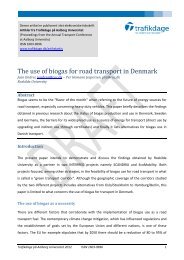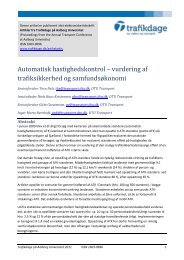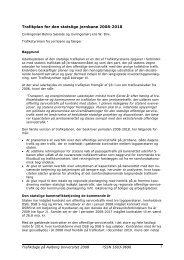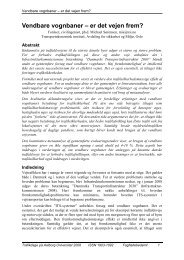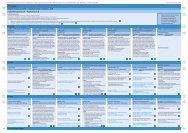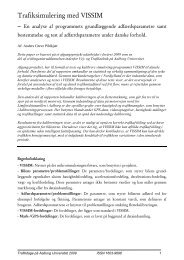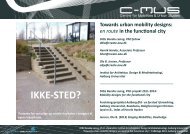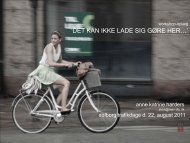Hent paperet som PDF-fil - Trafikdage.dk
Hent paperet som PDF-fil - Trafikdage.dk
Hent paperet som PDF-fil - Trafikdage.dk
You also want an ePaper? Increase the reach of your titles
YUMPU automatically turns print PDFs into web optimized ePapers that Google loves.
In order to prevent major costs occurring due to the possibly presence of market failures, town<br />
planning and other policy measures have to work as a proxy for an ideal consumer acting on a<br />
well-functioning market. Town planning should, at least ideally, function as an institutional<br />
regulation capable of mitigating the problems associated with market failures. Therefore, it is<br />
necessary in order to foster right decisions, that the planning measures and policies are based<br />
on relevant research and knowledge The rationale for this study is to contribute new<br />
knowledge to this problematic, but nevertheless, important and interesting research field.<br />
This can be achieved in several ways. One alternative can be labelled “social engineering”<br />
and involves identification, quantification and evaluation of different environmental factors in<br />
an expanded cost-benefit framework, where different methods can be used in the analysis,<br />
especially when evaluating. There are, however, major obstacles to be overcome when<br />
applying a traditional cost-benefit framework to these research questions. “An attractive inner<br />
city” is a very complex commodity with several attributes and qualities, difficult to<br />
decompose and value separately, which is necessary when performing cost-benefit<br />
calculations. Without rejecting the possibility of using traditional cost-benefit methods<br />
entirely, one must accept the severe problems associated with the approach in this particular<br />
case.<br />
There is also the political alternative of asking people directly through a referendum, which in<br />
a sense would make the research discussed in this paper <strong>som</strong>ewhat superfluous. The actual<br />
approach chosen in this project is a survey by means of questionnaires, the purpose of which<br />
is to determine the preference structure of individuals regarding different urban designs, with<br />
respect to the balance between individual car-access and the public benefits of a decrease in<br />
motor traffic.<br />
By allowing individuals to choose between different scenarios “packages” of environmental<br />
effects and transport benefits are in focus, thereby, at least in the ideal case, bypassing the<br />
decomposition problem following the traditional cost-benefit approach. If this approach is<br />
successful it can be used as an alternative to costly referendums and the results can be<br />
interpreted in economic terms and give the same information as a traditional cost-benefit<br />
calculation. All approaches, following traditional economic theory, must in an analytical<br />
sense be founded on the same balance between costs and benefits that would have been<br />
reflected in the equilibrium conditions and solutions on an ideally functioning market.<br />
The approach applied in the study is best suited for situations where the same individual<br />
confronts both costs and benefits as a result of different level of car access. The actual choice<br />
between different scenarios should in this case be the outcome of individuals balancing costs<br />
against benefits. This should be the factual situation for households living in residential areas<br />
in suburbs, and when the motor traffic in the inner city is in focus. Households living in the<br />
inner city can achieve individual gains from an extensive car access but encounter costs<br />
caused by the increase in the total motor traffic volume, in the same manner as the suburban<br />
inhabitants in their residential areas. Moreover, the quality of the inner city environment<br />
concerns everyone in the actual city, including those who travel to the central business district<br />
for shopping, recreation and, of course, work purposes.<br />
<strong>Trafikdage</strong> på Aalborg Universitet 2000 691


